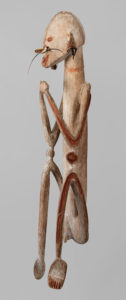
Asmat ancestral figure
(Credit: metmuseum.org)
For the Asmat of southwestern New Guinea, woodcarving is a tradition that dates back to their cultural understanding of the beginning of time. According to Asmat legend, the first being to exist on earth was Fumeripits, a lone individual who spent his days dancing on the beach. When Fumeripits grew tired of being alone, he chopped down several trees and carved them into human figures, which he placed inside his home, or “jeu.”
Still unhappy with his inanimate companions, Fumeripits decided to make a drum. He chopped down yet another tree, hollowed out the center and placed a lizard skin on top. When he began to play the drum, his wood carvings came to life and began to dance.
Today, Asmat woodcarvers are highly revered members of the Asmat tribe who follow in Fumeripits footsteps, creating beautiful, intricate wood sculptures to commemorate their ancestors, facilitate rites of passage and celebrate the dead. Many of these works are on display at the Metropolitan Museum in a collection donated by Michael C. Rockefeller in 1961.
Some of the most representative examples of Asmat wood carvings are ancestral figures such as the one shown at left. Although each sculpture is believed to have been created as a tribute to someone who recently died, the figures are all strikingly similar, with hands and knees joined in a posture resembling that of a fetus in utero, which is also the posture the Asmat believe the body assumes after death. The figures also closely resemble praying mantises, a fertility symbol long associated with the ancient Asmat practice of headhunting.

“Bis” pole
(Credit: arthistorywithivy.weebly.com)
Certainly the most striking examples of the Asmat art of woodcarving are ceremonial totems known as “bis” poles. Sometimes reaching heights of 20 feet or more, these intricately carved poles act as the focal point of a memorial feast honoring those who recently died. In ancient times, the poles were erected as reminders that the dead must be avenged, and “bis” feasts marked the beginning or a headhunting foray.
The “bis” pole is carved from a single Mangrove tree and is divided into three parts. The center, or “bis anakat,” consists of images of the person for whom the pole was created and his dead relatives (only men are celebrated in this way.) The top of the pole, the “cemen,” is crafted from a single tree root and is decorated with headhunting motifs. The bottom, the “ci,” is shaped like a canoe, which symbolically transports the dead to the afterworld. The pointed end of the pole anchors it in the ground.
Amazingly, these extremely intricate carvings are used only once and then discarded in a stand of sago palms, where they are left to rot or are ritually destroyed. Sago is the primary food source of the Amat, who believe the supernatural powers of the pole will nourish the earth and ensures an abundant sago harvest later on.

Amat spirit canoe
(Credit: holmes anthropolgymuseum.org)
Still another example of Asmat wood carvings are ceremonial “spirit canoes,” or “wuramon.” Like the “bis” pole, these intricately carved vessels depict the figures of those who have died, and are used in a single ritual, the bone house feast, which both celebrates the dead and serves as a rite of passage for young boys. Prior to the feast, the boys are secluded in a specially erected house, known as a Emaktsjim, for several days while the spirit vessel is built. Then, on the day of the ceremony, tribal elders take the canoe to the river and symbolically launch the spirits of the dead to Safan, the afterworld. They then return to the ceremonial house, where the door is opened and the boys emerge and crawl over the canoe one by one. On the other side, their bodies are decorated by the women of the village — a celebration of their symbolic transition into manhood.
The art and traditions of the Amat provide a rare glimpse into what is almost certainly soon to be a lost world. Learn more about their fascinating culture here.

 Ceremonial Art of the Asmat Depicts Life and Death
Ceremonial Art of the Asmat Depicts Life and Death


 The Other Death in the Family
The Other Death in the Family

 The Healing Sound of Singing Bowls
The Healing Sound of Singing Bowls














